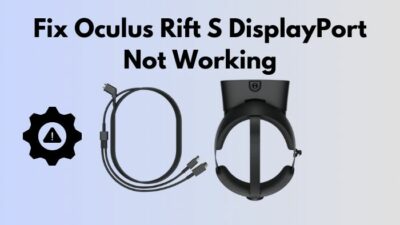You want to use AirPods with your Oculus Quest 2 to have a better listening experience.
But is it even possible to use AirPods with Oculus Quest 2?
Yes. But there are some catches you must be aware of.
This post will clear all your doubts and show you the process of connecting AirPods to Oculus Quest 2.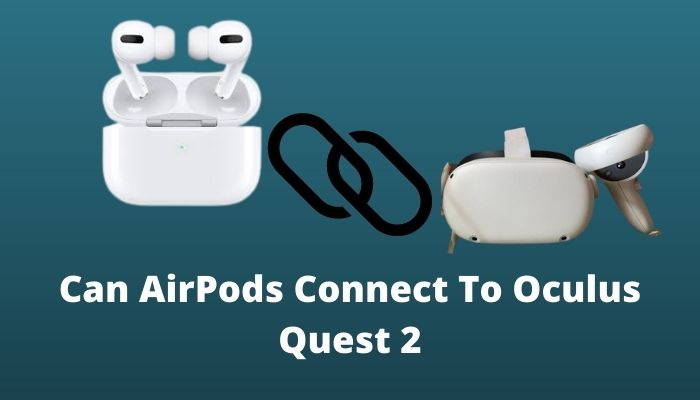
Let’s begin.
Can AirPods Connect To Oculus Quest 2?
The Oculus Quest 2 is one of the most popular VR headsets in the market. If you have a pair of Apple AirPods, you might be interested in using them with the Oculus Quest 2, as the Oculus Quest 2 headset doesn’t have top-quality audio.
But you’d be quite confused while looking for an official guide to connect AirPods with the VR headset, as Oculus Quest 2 doesn’t officially support AirPods or other Bluetooth headphones.
If you go through the official website, you will see that Oculus Quest 2 “supports both 3.5 mm headphones, as well as USB-C headphones”. But there’s no mention of connecting Bluetooth headphones with your Oculus Quest 2, like your AirPods.
However, don’t be disappointed, as Oculus Quest 2 has Bluetooth functionality and supported connecting wireless earbuds (including Apple AirPods and Galaxy Buds) via the Experimental Feature in Settings in its beginning days.
Later in March 2022, the Bluetooth setting was moved into the device settings, eliminating the need to turn on Experimental Features to use a Bluetooth connection.
As AirPods is a Bluetooth headphone, it can connect to the Oculus Quest 2 like a regular Bluetooth headphone. However, you would not get any special functionality of using AirPods or leverage the high-quality codec of the AirPods.
That means there will be some optimization, compatibility, and performance issues, as Oculus Quest 2 doesn’t officially support using wireless headsets and there are no optimizations.
But, if you can deal with these issues and still want to use Oculus Quest 2 and AirPods together, then you can do it. Or, you can resort to an alternative for dealing with quality issues.
Keep reading to know about the detailed process of connecting your AirPods to Oculus Quest 2, and also about the issues and their workarounds.
Check out our expert-recommended Can You Use AirPods For PS5.
How To Connect AirPods To Oculus Quest 2
You can connect Bluetooth headsets like AirPods Pro or AirPods Max to Oculus Quest 2 the same way you connect any other Bluetooth device by going inside Device Settings and connecting the Bluetooth headset using the Bluetooth pairing option.
Follow these steps to pair AirPods with the Oculus Quest 2:
- Turn on and wear your Oculus Quest 2 VR headset.
- Click on Quick Settings from the bottom taskbar.
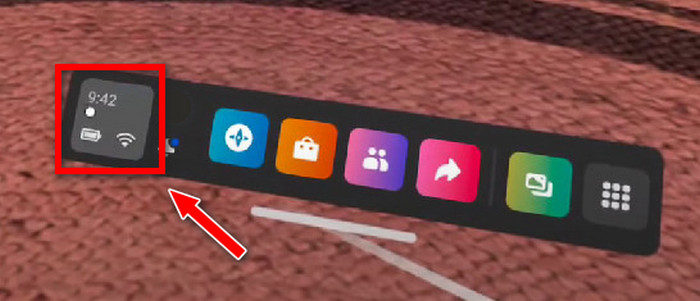
- Select Settings from the top-right corner.

- Go to Device settings.
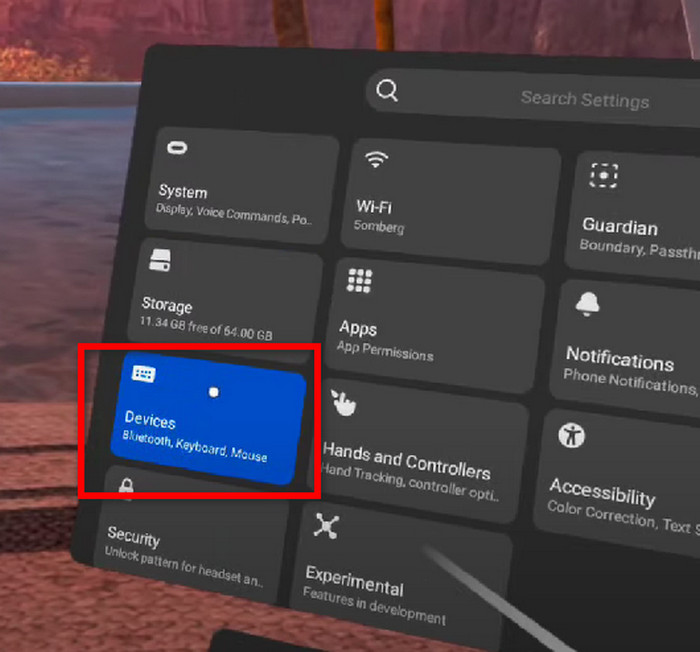
- Select Bluetooth from the left menu.
- Click on Pair.

- Put the AirPods in pairing mode. Keep the AirPods in their case with the lid open, then press and hold the button on the back of the case until the LED light on the case flashes white. Then the AirPods will be in pairing mode.
- Go back to the Oculus Quest 2 and select Pair a new device. Oculus Quest 2 will start searching for discoverable Bluetooth devices.

- Select AirPods from the nearby devices list. You will see a big prompt in front of you.
- Select Pair when asked if you want to connect the AirPods. It’ll pair the two devices.
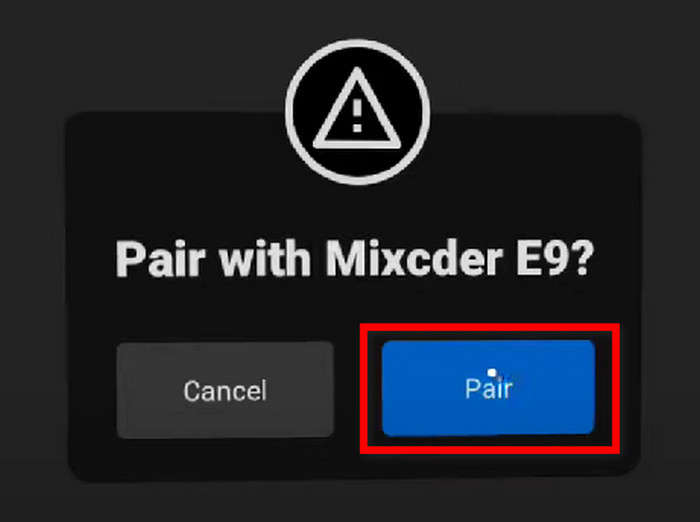
After completing the pairing process, you’ll see the AirPods in the list of connected devices in the Oculus Quest 2. You have successfully paired the AirPods with the Oculus Quest 2. Now you can listen to the Oculus Quest 2 wirelessly using the AirPods. 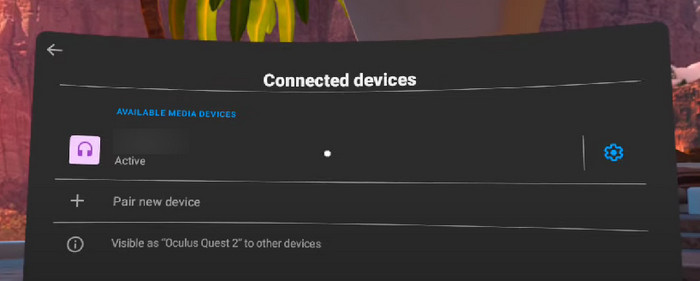
But one thing to note about using this method is that there are still some limitations on using the AirPods with the Oculus.
Here’s a complete guide to know the difference between Gear VR vs Oculus Quest.
Possible Issues While Using the AirPods with Oculus Quest 2
Since the Oculus Quest 2 doesn’t support Bluetooth headsets officially, the virtual reality headset is not optimized for the best Bluetooth audio quality. There’s no information on the Bluetooth features like codec and version that the VR headset uses.
As a result, there are some frequent issues while connecting the Oculus Quest 2 with AirPods.
Here is a list of issues using the AirPods with Oculus Quest 2:
- High audio latency: It does not always happen but you will occasionally notice some latency issues, especially when you are playing VR games. Since Oculus Quest 2 is not optimized for AirPods, the audio lag is quite high and might not be ideal for many games.
- Audio and video stutters: The Oculus Quest 2 doesn’t have a strong enough processor to handle fast-paced games simultaneously with AirPods or wireless headphones connection. This results in lagging, audio being out of sync, and frame drops which make the game unplayable. Since there’s mismatch in the audio codec of the two devices, the VR headset needs to allocate a large processing power to transcode the audio, resulting in stutters.
However, you should keep in mind that these issues are less noticeable if you are just streaming a movie or TV show on Netflix or Amazon Prime.
So, you must be wondering whether there is a workaround to these limitations of using AirPods with an Oculus device. You can find the answer to that in the next section.
Go through our epic guide on Fix Discord Airpods Not Working.
How To Fix Oculus Quest 2 Latency Issues With Bluetooth Headphones
Your Oculus Quest 2 VR headset will have a much easier time processing the audio from the Bluetooth transmitter than the AirPods.
The Bluetooth transmitter is a separate device that’ll plug into the 3.5mm audio jack of the VR headset. It’ll receive the audio from the Bluetooth headsets, process it and then send the audio to the VR headset. The VR headset will receive the audio as if it’s from a 3.5mm wired audio headset.
One of the main problems of using Bluetooth audio devices like AirPods with Oculus Quest is that the VR headset needs to process the audio alongside playing games or whatever else you’re doing on the VR. This wireless audio results in latency issues and frame drops.
But as you use an external Bluetooth transmitter, it will do a major portion of the transcoding and processing. Hence the burden on the VR headset processor will be removed and it can focus on processing the game.
It’s not like there will be zero latency when listening to audio using a Bluetooth transmitter but typically, there is around a 40ms lag when using the transmitter which is decent enough for gaming.
Another important point to consider is that the quality of your Bluetooth transmitter must be above average if you want to have a truly immersive VR experience. You should look for a transmitter that supports at least Bluetooth 4.2 and has a range of 10m.
Once you have found the perfect Bluetooth transmitter, all you need to do is connect the Bluetooth/wireless headset or AirPods to the transmitter after it’s properly plugged into the 3.5 mm port of the Oculus Quest 2.
Most people make the mistake of connecting their AirPods with the Oculus Quest 2 with the transmitter plugged in. If you do this, you won’t notice any latency improvements because you are not using the transmitter at all.
I would also like to add that if you want to get the ultimate and immersive wireless experience out of your Oculus Quest 2 VR headset, simply use wired earphones with it. You will be listening to almost zero latency and uncompressed high-quality audio.
Check out our separate post on Airpods Not Working in Zoom on Mac.
FAQ
Question: Can I use my AirPods pro with Oculus Quest 2?
Answer: Yes, you can connect your Apple AirPods Pro with Oculus Quest 2 by connecting them like a regular Bluetooth device.
Question: Can you use the AirPods Max with Quest 2?
Answer: Yes, you can use the AirPods Mac with Quest 2 like any other Bluetooth earphone.
Question: Can I use any headphones with Oculus Quest 2?
Answer: Oculus Quest 2 officially supports 3.5mm and USB-C earphones. To use a Bluetooth headphone, you have to connect Bluetooth headphones to Oculus Quest 2 like a regular Bluetooth device. You might face frame drops and high latency while using Bluetooth earphones.
Final Thoughts
That’s all I have to say about how you can connect your AirPods or any other wireless Bluetooth headphones to Oculus Quest 2 and what problems you might be experiencing.
Just like I mentioned earlier, you need to consider whether you actually want to use your AirPods by thinking about whether audio latency or lags during gameplay is a dealbreaker for you.
I hope you learned something from this guide and know where to reach us when you need information on topics like these.




